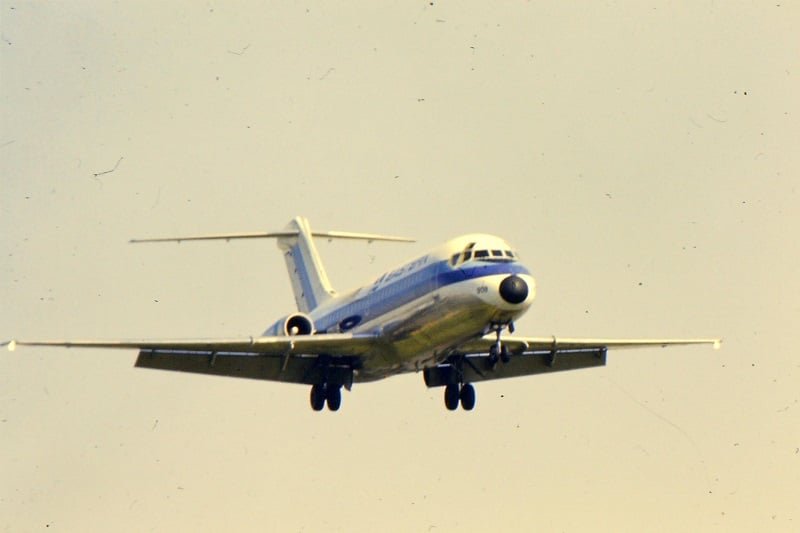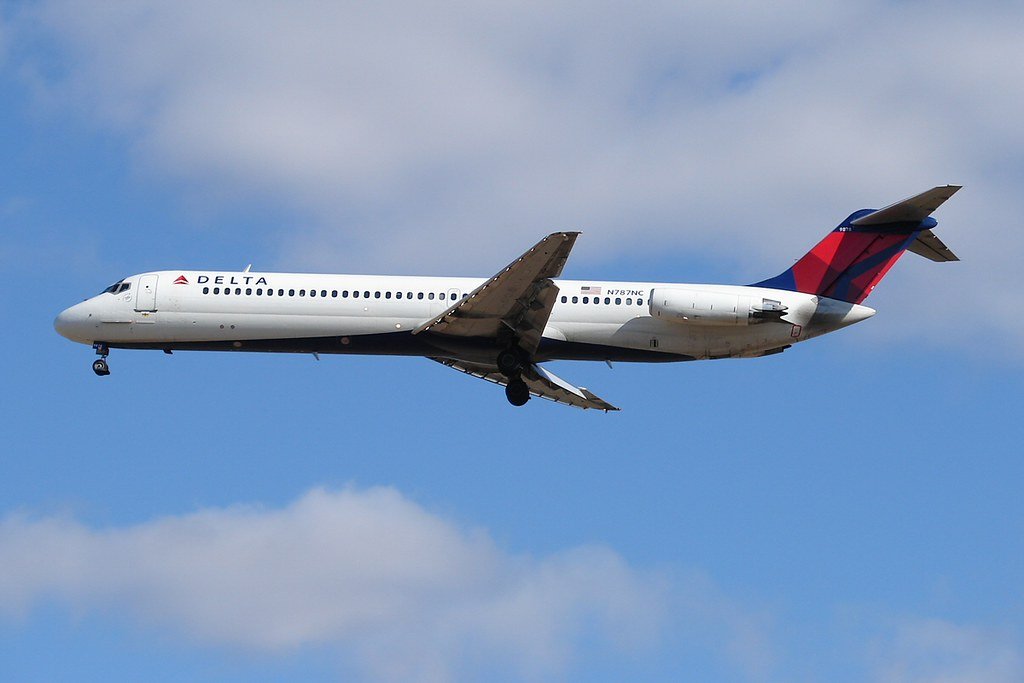
Douglas
DC 9.
SPECS
HISTORY
ORDERS
Douglas DC9-15 British Midland registration G-BMAB. Named Merseyside.
The Douglas DC-9 is a short to medium-range airliner and was the last to be fully designed and produced by the Douglas Aircraft Corporation.
Back in the 1950s, Douglas was looking to fill the short to medium-range airliner space. They already had the DC-8 which served the medium to long-range and intercontinental market. But now they needed to find a solution to be able to serve small and remote locations as well.
The investigation into a solution took several different turns and many years before a final design was settled upon. They looked into a scaled-down 4-engine version that slightly resembled the Convair 880, a model that didn't really meet with any success. Douglas also looked at what European manufacturers were doing, with a particular interest in the British Aircraft Corporation's BAC111 and Sud Aviation's Caravelle.
Eastern Airlines DC-9-10 registration N8909E. Here we see the large flaps uninterrupted by wing-mounted engines.
The DC9 design is a twin-engine airliner with two rear fuselage-mounted engines, namely the Pratt and Whitney JT8D turbofans. The tail is a T-tail configuration with horizontal stabilisers mounted on top, and the main wings are small and of a highly efficient design. In fact, the first model, the DC-9-10 had no leading edge slats as the wing was designed for high lift to aid with short-field performance.
This design had several advantages in that no engines on the wings meant more uninterrupted lifting surface area. Additionally, the flaps could run the entire length of the wing, providing a much higher amount of lift in those lower-speed stages of flight.
The absence of engines slung below the wings also meant that the aircraft could be lower to the ground on its undercarriage. This allowed for much easier access for baggage handlers.
SPECIFICATIONS
Douglas DC 9 Specs Table
| -10 | -20 | -30 | -40 | -50 | |
|---|---|---|---|---|---|
| Flight Crew | 2 | ||||
| Milestones | |||||
| Maiden Flight | 25 FEB 1965 | 18 SEP 1968 | 01 AUG 1966 | 28 NOV 1967 | 1974 |
| Entry Into Service | 08 DEC 1965 | 27 JAN 1969 | FEB 1967 | MAR 1968 | AUG 1975 |
| Launch Airline | Delta Air Lines | Scandinavian Airline System | Eastern Air Lines | Scandinavian Airline System | Eastern Air Lines |
| Number Produced | 137 | 10 | 621 | 71 | 96 |
| Dimensions | |||||
| Number of Passengers (1 class) | 90 | 115 | 125 | 135 | |
| Passenger Limit by Exits | 109 | 127 | 128 | 139 | |
| Aircraft Length | 31.82M (104F 5I) | 36.36M (119F 4I) | 38.28M (125F 7I) | 40.72M (133F 7I) | |
| Height | 8.4M (27F 7I) | 8.5M (27F 11I) | 8.7M (28F 5I) | 8.8M (28F 9I) | |
| Wing Span | 27.25M (89F 5I) | 28.44M (93F 4I) | 28.44F (93F 4I) | 28.45M (93F 4I) | |
| Fuselage Width | 3.34M (11F) | ||||
| Cabin Width | 3.11M (10F 2I) | ||||
| Cargo | 17M3 600F3 | 25.3M3 895F3 | 28.9M3 1,019F3 | 33.2M3 1,174F3 | |
| Weights | |||||
| Max. Takeoff Weight(MTOW) |
41,141K (90,700lb) | 45,359K (98,000lb) | 48,988K (108,000lb) | 51,710K (114,000lb) | 54,885K (121,000lb) |
| Max. Landing Weight(MLW) |
37,058K (81,700lb) | 43,227K (95,300lb) | 44,906K (99,000lb) | 46,266K (102,000lb) | 49,895K (110,000lb) |
| Max. Empty Weight(MEW) |
22,300K (49,162lb) | 23,879K (52,644lb) | 25,789K (56,855lb) | 27,821K (61,335lb) | 29,336K (64,675lb) |
| Max. Fuel | 11,223K (24,743lb) | 11,181K (24,649lb) | |||
| Performance | |||||
| Engines x 2 | JT8D (Various models) | ||||
| Thrust | 54.5kN(12,250lbf) - 71kN(16,000lbf) | ||||
| Ceiling | 35,000F (11,000M) | ||||
| MMo | 484Kn / Mach 0.84 / 897kph | ||||
| Range | 1,300NM (2,400Km) | 1,500NM (2,800Km) | 1,200NM (2,200Km) | 1,300NM (2,400Km) | |
Both the Caravelle and the BAC-111 were twin rear-mounted engined airliners playing in the same space, the short to medium range that Douglas was aspiring to. The Douglas Aircraft Corporation even went so far as to sign a contract with Sud Aviation of France to build a Caravelle-based aircraft under licence, provided they got enough interest.
Customers stayed away in droves, so that agreement was abandoned in 1960.
Douglas went back to the drawing board in 1962 with a view to designing a 63-seat airliner weighing 36,300Kg (80,000lb). On the 8th of April 1963, Douglas approved the new design and the DC-9 was on its way to becoming an actuality.
History.
Delta McDonnell Douglas DC-9-50. Delta Air Lines was the launch customer in 08 December 1965.
The first production model of the DC-9 took to the air on 25 February 1965 and by July of that year was accompanied by four more. After an intensive testing program, certification was granted for the type on 23 November 1965. The certification limited the aircraft weight to 36,300Kg (80,000lbs) due to the two-man crew configuration. This restriction was later lifted, which was good news as Douglas always intended the DC-9 to come out in various configurations and sizes.
Launch customer, Delta Air Lines, received its first DC-9 0n 08 December 1965.
This South African Express DC9-32 registration ZS-GAR nicely illustrates the built-in tail door. The DC 9 did not have to rely on airport services in remote locations.
To look at, one could notice some similarities to the BAC-111. However, the DC-9 was designed for short hops, some of which would be to un-serviced airfields.
Douglas designed some autonomy into the DC-9 so that it was not dependent on ground services at these airports. These features included an A.P.U. (Auxilary Power Unit), which was a smaller engine housed inside the rear fuselage. This engine would be activated whilst the aircraft was on the ground with the main engines powered off. It would supply any electricity requirements whilst the aircraft was stationary and also the power to restart the main engines.
In addition, a passenger staircase was located in the rear of the aircraft which dropped down between the engines from the bottom of the fuselage. This enabled boarding without the aid of airport-provided stairs.
Northwest Airlines NWA McDonnell Douglas DC-9-30 registration N1332U. First flying on 01 August 1966, 662 of the type were built.
An additional optional feature was a front door stairway which stowed itself under the floor beneath the main passenger left-hand front door. On activation, a flap on the exterior below the door would open and the stairway would be slid out in a folded condition by an actuator motor. It would move out horizontally until fully extended, at which time it would then ease down to the ground with the handrail deploying as it went. This was also an option for early Boeing 737 aircraft as well.
As mentioned above, Doulas always intended to produce different variants of the DC-9. For example, the DC-9-10 was also produced as a passenger/cargo version, in fact, two versions. They were the 15MC9 Minimum Change where at night when passenger services ceased the seats could be folded to the rear and cargo carried overnight. The other option was the 15RC Rapid Change, where the seats were removed on pallets giving use of the full cabin for cargo. Both models were supplied with a 3.5M x 2.1M cargo door forward of the wing and a strengthened floor.
Kalitta Charters II Douglas DC9-15F registration N917CK.
New competition was emerging from the Boeing camp in the form of the Boeing 737 and Douglas rose to the challenge with the DC-9-30. This variant had a longer fuselage, and extended wing tips and was offered with various versions of the JT8D engine as well as full-length wing slats. First flying on 01 August 1966, it entered service with Eastern Air Lines in February 1966. 662 of the type were built.
In response to requests from Scandinavian Airlines System (SAS) which needed a variant designed for short-field operations, Douglas came up with the DC-9-20. This model came with more powerful engines and the larger wing of the DC-9-30 which provided the higher performance required by SAS. First flying on 18 September 1968, the type gained certification on 25 November 1968 and was delivered to SAS on 11 December 1968.
SAS, the only customer for DC-9-20, flew their first service with the type on 27 January 1969. The order for ten airframes was concluded with the last delivery on 01 May 1969.
SAS Scandinavian Airline Systems DC-9-21 registration OY-KIA. SAS was the only airline to order the DC9-20 series.
Douglas further lengthened the DC-9 in the form of the DC-9-40. First flying in March 1968 with SAS, Douglas went on to build 71 of the type.
The largest of the DC-9 family of airliners was the DC-9-50. First flying in 1974, it entered service with Eastern Air Lines in August of 1975. Ninety-six of the type capable of carrying 139 passengers were delivered.
As technology improved, each new variant came with updated features and improvements. The -50 came with a small fin under each of the side cockpit windows, spray deflectors for the nose wheel, and the reverse thrust angled up 17 degrees. The latter was developed by Air Canada and adopted by the aircraft maker.
Delivering 976 DC-9 aircraft, the merged McDonnell Douglas company (1967) saw this as a great success.
The last DC-9 was delivered in 1982. That was not the end of the story. McDonnell Douglas went on to produce the MD-80 and the MD-95. The latter was actually renamed the Boeing 717 when McDonnell Douglas merged with Boeing in 1997.
Delta Air Lines DC-9-50 registration N787NC. The -50 was the larger of the DC-9 series.
Orders and Deliveries.
| Customers | DC-9 | |
|---|---|---|
| Ordered | Delivered | |
| Adria Airways d.d. | 7 | 7 |
| Aero Trasporti Italiani | 14 | 14 |
| Aeromexico | 25 | 24 |
| Aeropostal | 9 | 9 |
| Air Atlantis | 3 | 3 |
| Air Canada | 50 | 50 |
| Air Jamaica | 3 | 3 |
| Air Serbia | 14 | 14 |
| Alitalia | 38 | 38 |
| Ansett Australia | 12 | 12 |
| ATAircraft One | 7 | 7 |
| Australian Airlines Limited | 12 | 12 |
| Austrian Airlines | 15 | 14 |
| AVENSA | 3 | 3 |
| AVIACO | 16 | 16 |
| Balair/CTA | 2 | 2 |
| Bonanza Airlines | 4 | 4 |
| BWIA | 5 | 5 |
| Delta Air Lines | 77 | 77 |
| Dominicana Airlines | 1 | 1 |
| Dutch Caribbean Airlines | 3 | 3 |
| East African Airways | 3 | 3 |
| Eastern Air Lines | 96 | 96 |
| EgyptAir | 6 | 0 |
| Finnair | 12 | 12 |
| Garuda Indonesia | 25 | 25 |
| Ghana Airways | 1 | 1 |
| Hawaiian Airlines | 20 | 20 |
| Hughes Airwest, Inc. | 16 | 16 |
| Iberia Airlines | 35 | 35 |
| Customers (Contd.) | DC-9 | |
|---|---|---|
| Ordered | Delivered | |
| Italian Air Force | 2 | 2 |
| Japan Airlines Co., Ltd. | 22 | 22 |
| KLM Royal Dutch Airlines | 24 | 24 |
| Korean Air | 1 | 1 |
| Kuwait Air Force | 2 | 2 |
| Martinair Cargo | 4 | 4 |
| Midway Airlines | 5 | 0 |
| NEA Holdings, Inc. | 15 | 15 |
| North Central Airlines | 41 | 41 |
| Ozark Air Lines | 19 | 19 |
| Pacific Southwest Airlines | 2 | 2 |
| Pan Adria | 1 | 1 |
| Playboy | 1 | 1 |
| Purdue Airlines | 2 | 2 |
| Republic Airlines | 7 | 7 |
| Saudi Arabian Airlines | 3 | 3 |
| Scandinavian Airlines | 61 | 61 |
| Southern Airways - USA | 15 | 11 |
| Spantax | 2 | 0 |
| Standard Airways | 2 | 2 |
| Suedflug | 2 | 2 |
| Swissair | 40 | 37 |
| Texas Air Corporation | 20 | 20 |
| Tracinda Corp. | 1 | 1 |
| Trans Carib Air | 3 | 3 |
| Turkish Airlines | 10 | 10 |
| TWA | 20 | 20 |
| U.S. Air Force | 24 | 24 |
| United Airlines | 23 | 23 |
| United States Navy | 20 | 17 |
| US Airways, Inc. | 69 | 69 |
| West Coast Airlines - UK (Inac | 4 | 4 |
| Grand Total | 1001 | 976 |












